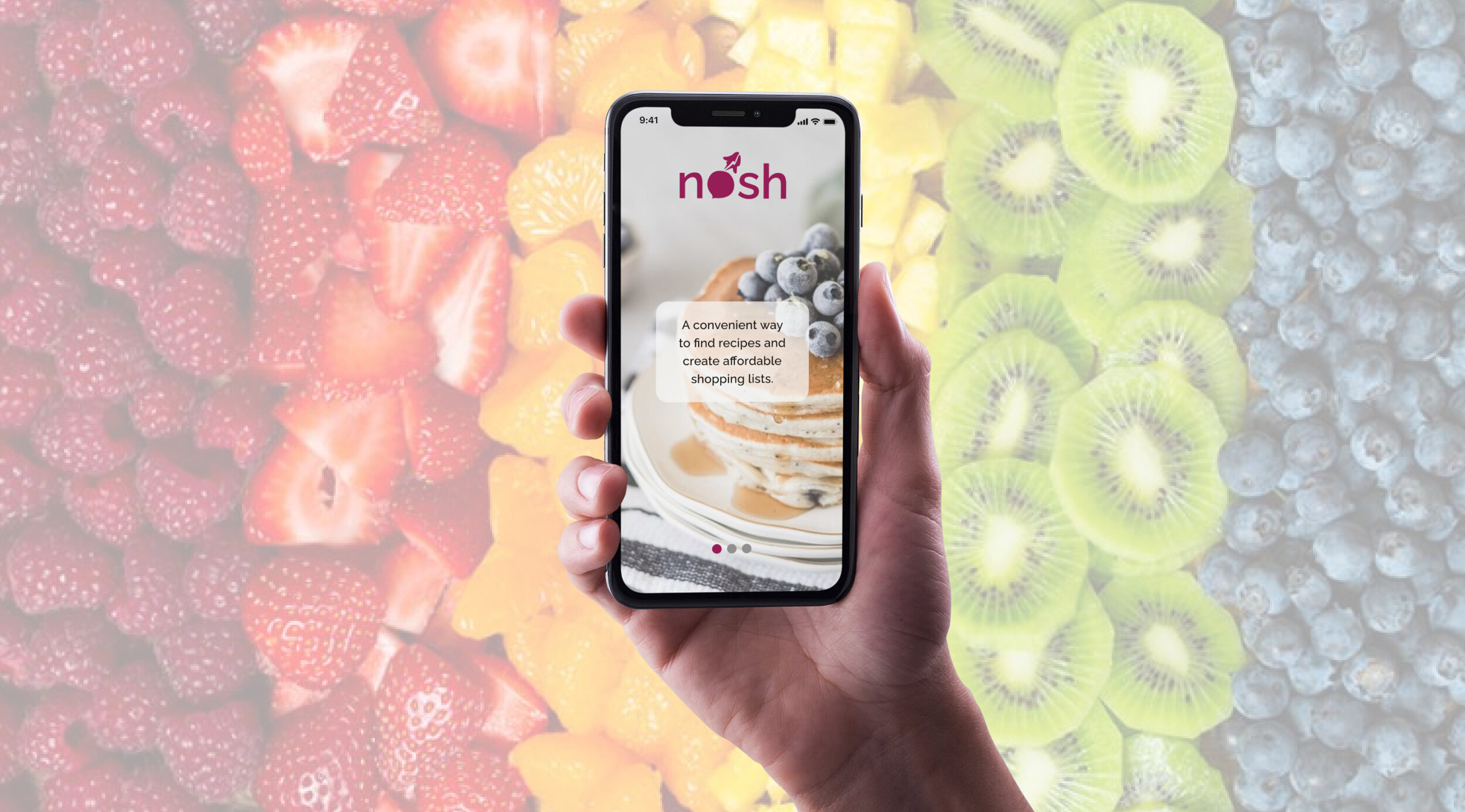
CONTEXT
What is Nosh?
Nosh makes grocery shopping manageable and finding recipes that are in line with your lifestyle and preferences. Start by taking a photo of your fridge, pantry, or kitchen shelves to help Nosh better recommend recipes and create shopping lists.
Problems
Users want to be able to use Nosh to be able to do the following things based on the conclusions drawn from the user research team -
Incorporate image recognition technology to show what users have in their kitchens
Recommend recipes and complete shopping lists based on the user’s lifestyle and preferences.
DISCOVERY & RESEARCH
Scope
Nosh aims to offer a product to users that incorporates machine learning AI to help them make cooking, shopping, and finding recipes manageable.
I was provided the UX research by a fictitious team that gave me the following deliverables: personas, style guide, and target audience.
Users & Audience
Challenges
Lack of time and resources
Lack of skills
Demographics
22-40 years old
Female
Location: NYC and other large urban areas
$40K - $80K annual salary
Psychographics
Health-conscious
View food as a social thing
Want to exercise and stay fit
Intimidated by cooking
Persona
The UX Research team provided me with multiple personas and I decided to focus on Gabrielle Sanchez. Gabrielle is a 28 year-old graphic designer who views food as a way to get to know someone. She enjoys cooking restaurant quality food at home and bonding with others over their mutual love for food and new experiences. She’s eager to get better at cooking and wants to push herself and her interests by finding more elaborate and unique recipes.
User Stories
Below are the highest priority user stories that I designed for:
As a user, I want to be able to take a picture and capture the food i have in my kitchen to help me find recipes and ingredients I’m missing.
As a user, I want to be able to review recommended recipes that are in line with my preference and lifestyle.
As a user, I want to be able to purchase items off my shopping list.
IDEATION
Visual Scenario
V1 used the original logic of having users search for items and supermarkets to populate their shopping list. This flow was flawed because it didn’t appeal to the user persona we were tasked with designing for. The user persona, Gabrielle, doesn’t have time and wants help creating her shopping list and inspiring her meal choices for the week.
V2 incorporates image recognition technology making it easier for the user to scan their physical inventory and help the product curate a list of recipes that incorporate the scanned items and the user’s preferences. Below is a visual of the scenario a user will go through when using V2 of this product -
Wireframing
The UX Research team’s original design thinking prioritized searching for items and supermarkets to find items to add to their shopping list. The wireframes required a heavy cognitive load at the beginning of the user journey and I wanted to change that. Users don’t know what they want to shop for until they figure out what they want to make. That’s why I prioritized the fridge scan and discovering recipes as the main two features. V2 of the wireframes prioritizes these features and you can see it below -
BRANDING
Original Style Guide
I was provided the original style guide by the UX Research team and you can see it below -
Redesigned Style Guide
While I used majority of the elements provided above, I felt a few changes needed to be made to create a product that was more in line with Nosh’s target audience. I wanted to create a social and trendy brand that really popped. The color palette needed to inspire interaction and a lifestyle change. The new logo is all lowercase to make it feel “softer.” I added the Raleway font to give a distinction between body text and titles.
High Fidelity Screens
CONCLUSION
Takeaways
Users liked the feel and aesthetic of the product, however didn’t think it’d be their go to source or product for finding recipes and creating a shopping list. Users liked the fridge scan and machine learning features, however were skeptical about the accuracy of both.
The UI of the product received high praise during user testing and users appreciated how minimal the screens were allowing them to focus on action points and elements.
Learnings
Working with pre-defined materials and deliverables is great to get the process going, however it’s important to validate the existing information prior to jumping in the the design process. Ask questions and iterate on things that don’t make sense to you with the help of other team members.
User flows are very important when trying to create a product that intuitively flows from goal to goal.
Conduct focused and specific user testing scenarios to validate assumptions and research.
Ask users if they have any questions after explaining the scenario and prior to starting the actual user test. Providing context or answering any questions they have prior to running the actual test will help give them a more realistic approach for a conceptual product and project.
If you have any questions, or want to learn more about Nosh, feel free to contact me .
